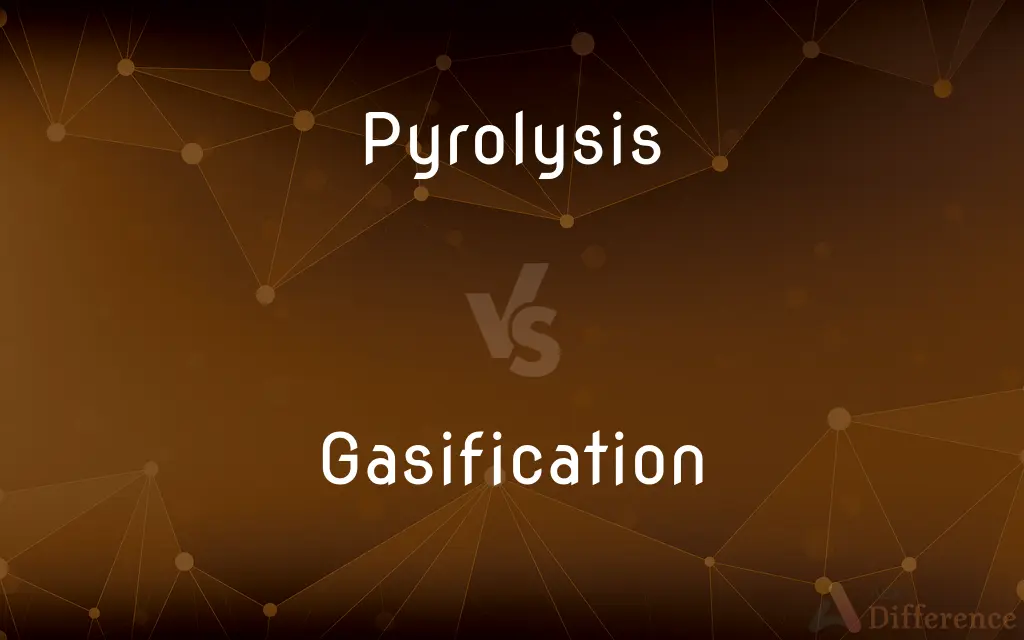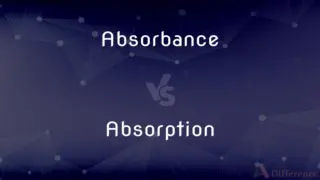Pyrolysis vs. Gasification — What's the Difference?
Edited by Tayyaba Rehman — By Fiza Rafique — Updated on October 5, 2023
Pyrolysis involves thermally decomposing materials in the absence of oxygen, while gasification also involves high-temperature decomposition but with controlled oxygen to produce syngas.

Difference Between Pyrolysis and Gasification
Table of Contents
ADVERTISEMENT
Key Differences
Pyrolysis and gasification, while bearing similarities as thermochemical processes, indeed harbor distinctions mainly anchored in their operational parameters and objectives. Pyrolysis pertains to the thermal decomposition of organic materials, subjected to elevated temperatures in the absence of oxygen, driving a chemical alteration to spawn various co-products, such as biochar, bio-oil, and gases. Gasification, while also utilizing heat to provoke chemical changes, involves partially combusting the material under restricted oxygen supply, thereby predominantly generating syngas, composed of carbon monoxide and hydrogen.
The utility of pyrolysis typically leans towards deriving multiple valuable products from organic matter, using it as a strategy to transform biomass into useful forms, like bio-oil for potential biofuel production. Gasification conversely finds its significance largely in the production of syngas, which can be utilized as a fuel or further processed to synthesize chemicals or other fuels. The applications for these two methods thus distinctively branch based on the outputs they yield and the subsequent utility of these outputs in various industrial applications.
An evident differentiator between pyrolysis and gasification arises from their intrinsic process conditions, particularly concerning the involvement of oxygen. Pyrolysis strictly denies the presence of oxygen, ensuring an anoxic environment to thwart combustion and promote thermal decomposition. On the other hand, gasification employs a deliberately controlled quantity of oxygen, calibrated to facilitate partial combustion and consequently drive the generation of syngas, maintaining a precise equilibrium between the thermal decomposition and partial oxidation.
Delving into the material outputs derived from pyrolysis and gasification, there’s a tangible disparity in the product slate they each offer. Pyrolysis, due to its anoxic operational modality, yields a range of products like pyrolytic oil, gas, and char, each holding potential for various applications. Gasification predominantly leans towards the production of syngas, albeit yielding some byproducts like tar and ash, with the syngas typically being the main object of interest due to its utility as a versatile fuel and chemical feedstock.
In an environmental context, pyrolysis and gasification each offer plausible strategies towards managing waste and harnessing energy from biomass in a potentially sustainable manner. The strategic adoption of pyrolysis could be oriented towards harnessing diverse co-products and exploiting them in various industries. Gasification's avenue of utility leans significantly towards energy generation and chemical production, providing a pathway to convert waste and biomass into useful energy and chemical precursors with possible lower environmental impacts than conventional combustion processes.
ADVERTISEMENT
Comparison Chart
Oxygen Presence
Absent
Present in controlled amounts
Primary Products
Biochar, Bio-oil, Gas
Syngas
Process Objective
Decomposition without combustion
Partial combustion to produce syngas
Temperature
High
High, often higher than pyrolysis
Applications
Biofuel, Chemical production, Soil amendment
Energy production, Chemical synthesis
Compare with Definitions
Pyrolysis
A technique to alter the chemical composition of materials via heat.
Using pyrolysis, tires can be broken down into gases and oils.
Gasification
A partial combustion method to convert materials into gaseous fuel.
Biomass gasification produces syngas that can be utilized in electricity generation.
Pyrolysis
A method to break down materials using high heat and no air.
Pyrolysis can transform plastic waste into useful fuels.
Gasification
A process using heat and limited oxygen to produce syngas.
Gasification of coal provides a cleaner-burning fuel in the form of syngas.
Pyrolysis
The process to produce bio-oil, gas, and char from biomass.
Through pyrolysis, agricultural residues can be converted into bio-oil.
Gasification
The transformation of carbonaceous substances into gas using heat.
Gasification can aid in managing waste by converting it into usable fuel.
Pyrolysis
A thermochemical decomposition of organic material without oxygen.
Pyrolysis converts wood into biochar, useful for soil amendment.
Gasification
A technique to generate syngas from organic or fossil-based materials.
Through gasification, various feedstocks can contribute to synthesizing chemicals.
Pyrolysis
An anoxic thermal decomposition procedure for organic substances.
Pyrolysis is employed to generate gases from municipal solid waste.
Gasification
Gasification is a process that converts biomass- or fossil fuel-based carbonaceous materials into gases, including as the largest fractions: nitrogen (N2), carbon monoxide (CO), hydrogen (H2), and carbon dioxide (CO2). This is achieved by reacting the feedstock material at high temperatures (typically >700 °C), without combustion, via controlling the amount of oxygen and/or steam present in the reaction.
Pyrolysis
Pyrolysis is the thermal decomposition of materials at elevated temperatures in an inert atmosphere. It involves a change of chemical composition.
Gasification
To convert into or become gas.
Pyrolysis
Decomposition or transformation of a compound caused by heat.
Gasification
The action of gasifying.
Pyrolysis
The decomposition of a material or compound due to heat, in the absence of oxygen or other reagents.
Gasification
(chemistry) The process of transforming carbon-based materials into a mix of carbon monoxide and hydrogen that can serve as fuel.
Pyrolysis
Transformation of a substance produced by the action of heat
Gasification
The act or process of converting into gas.
Gasification
The process of changing into gas;
Coal gas is produced by the gasification of coal
Gasification
A procedure using controlled oxygen and heat to derive gases.
Gasification can turn organic waste into a valuable resource of syngas.
Common Curiosities
Can gasification work without any oxygen?
No, gasification requires a controlled amount of oxygen for partial combustion.
Are pyrolysis and gasification considered green technologies?
They can be, especially when utilizing waste or biomass, reducing landfill use, and generating energy or valuable products.
How is gasification related to syngas production?
Gasification is a process that partially burns materials to primarily produce syngas.
What kind of feedstock can be used in gasification?
Biomass, coal, and certain wastes can be used as feedstock in gasification.
How does pyrolysis affect the environment?
When well-managed, pyrolysis can be a sustainable waste management and energy production strategy, minimizing landfill usage and producing valuable products.
Can pyrolysis work with all types of organic matter?
Pyrolysis can process a wide range of organic materials, though feedstock properties will affect the process and products.
What is pyrolysis?
Pyrolysis is the thermal decomposition of materials in the absence of oxygen.
Is pyrolysis applicable for plastic waste management?
Yes, pyrolysis can convert certain plastic wastes into fuels and other valuable products.
Can pyrolysis be used for food waste?
Yes, pyrolysis can process food waste, yielding products like biochar and gases.
What is a primary product from gasification?
The primary product from gasification is syngas, a mixture of carbon monoxide and hydrogen.
Is gasification technology widely used?
Gasification is employed in various regions globally for power generation and chemical production.
Is syngas from gasification clean?
Syngas may require cleaning to remove contaminants like tar and particulates before use.
Is gasification efficient for power generation?
Gasification can be an efficient way to generate power when utilizing the produced syngas in combined heat and power systems.
Can pyrolysis produce liquid fuel?
Yes, pyrolysis can produce bio-oil, a liquid which can be refined into fuels.
Can pyrolysis and gasification be integrated into a single process?
Yes, certain systems integrate both, often using pyrolysis first, followed by gasification of the resultant char to maximize syngas production.
Share Your Discovery

Previous Comparison
Absorbance vs. Absorption
Next Comparison
Nap vs. SnapAuthor Spotlight
Written by
Fiza RafiqueFiza Rafique is a skilled content writer at AskDifference.com, where she meticulously refines and enhances written pieces. Drawing from her vast editorial expertise, Fiza ensures clarity, accuracy, and precision in every article. Passionate about language, she continually seeks to elevate the quality of content for readers worldwide.
Edited by
Tayyaba RehmanTayyaba Rehman is a distinguished writer, currently serving as a primary contributor to askdifference.com. As a researcher in semantics and etymology, Tayyaba's passion for the complexity of languages and their distinctions has found a perfect home on the platform. Tayyaba delves into the intricacies of language, distinguishing between commonly confused words and phrases, thereby providing clarity for readers worldwide.













































